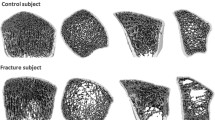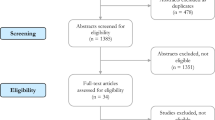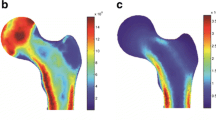Abstract
Objectives
To evaluate the feasibility of HU histogram analysis (HUHA) to assess proximal femoral fragility fractures with respect to BMD.
Methods
This retrospective study included 137 patients with femoral fragility fractures who underwent hip CT and 137 control patients without fractures who underwent abdominal CT between January 2018 and February 2019. HUHA was calculated with the 3D volume of interest from the femoral head to the lesser trochanter. HUHAfat (percentage of negative HU values) and HUHAbone (percentage of HU values ≥ 125 HU) were assumed to be fat and bone components, respectively. Statistical significance was assessed using the area under the receiver operating characteristic curve (AUC), Spearman correlation (ρ), and odds ratio.
Results
HUHAfat was strongly positively correlated (ρ = 0.56) and BMD was moderately negatively correlated with fragility fractures (ρ = − 0.37). AUC of HUHAfat (0.82, 95% CI [0.77, 0.87]) significantly differed from that of BMD (0.69, 95% CI [0.63, 0.75]) (p < .001). The cutoff value was 15.8% for HUHAfat (sensitivity: 90.4%; specificity: 67.7%) and 0.709 g/cm2 for BMD (sensitivity: 87.5%; specificity: 51.5%), with higher HUHAfat and lower BMD values indicating fragility fractures. The odds ratio of HUHAfat was 19.5 (95% CI [9.9, 38.2], p < .001), which was higher than that of BMD, 7.4 (95% CI [4.0, 13.6], p < .001).
Conclusion
HUHAfat revealed better performance than BMD and demonstrated feasibility in assessing proximal femoral fragility fractures.
Key Points
• HUHA fat showed a strong positive correlation (Spearman ρ = 0.56, p < .001), and BMD showed a moderate negative correlation (Spearman ρ = − 0.37, p < .001) with proximal femoral fragility fractures.
• HUHA fat (AUC = 0.82) performed significantly better than BMD in assessing proximal femoral fragility fractures (AUC = 0.69) (p < .001).
• The odds ratio of HUHA fat for proximal femoral fragility fractures was higher than that of BMD (19.5 and 7.4, respectively; p < .001).





Similar content being viewed by others
Abbreviations
- BMD:
-
Bone mineral density
- DXA:
-
Dual-energy X-ray absorptiometry
- HU:
-
Hounsfield unit
References
Burge R, Dawson-Hughes B, Solomon DH, Wong JB, King A, Tosteson A (2007) Incidence and economic burden of osteoporosis-related fractures in the United States, 2005–2025. J Bone Miner Res 22(3):465–475
Metcalfe D (2008) The pathophysiology of osteoporotic hip fracture. Mcgill J Med 11(1):51–57
Kani KK, Porrino JA, Mulcahy H, Chew FS (2019) Fragility fractures of the proximal femur: review and update for radiologists. Skeletal Radiol 48(1):29–45
Dragomir-Daescu D, Op Den Buijs J, McEligot S et al (2011) Robust QCT/FEA models of proximal femur stiffness and fracture load during a sideways fall on the hip. Ann Biomed Eng 39(2):742–755
Fujii M, Aoki T, Okada Y et al (2016) Prediction of femoral neck strength in patients with diabetes mellitus with trabecular bone analysis and tomosynthesis images. Radiology 281(3):933–939
Poole KES, Skingle L, Gee AH et al (2017) Focal osteoporosis defects play a key role in hip fracture. Bone 94:124–134
Hong W, Ha HI, Lee JW, Lee SM, Kim MJ (2019) Measurement of pancreatic fat fraction by CT histogram analysis to predict pancreatic fistula after pancreaticoduodenectomy. Korean J Radiol 20(4):599–608
Lim HK, Ha HI, Park SY, Lee K (2019) Comparison of the diagnostic performance of CT Hounsfield unit histogram analysis and dual-energy X-ray absorptiometry in predicting osteoporosis of the femur. Eur Radiol 29(4):1831–1840
Lee HW, Ha HI, Park SY, Lim HK (2020) Reliability of 3D image analysis and influence of contrast medium administration on measurement of Hounsfield unit values of the proximal femur. PLoS One 15(10):e0241012
Rivadeneira F, Zillikens MC, De Laet CE et al (2007) Femoral neck BMD is a strong predictor of hip fracture susceptibility in elderly men and women because it detects cortical bone instability: the Rotterdam Study. J Bone Miner Res 22(11):1781–1790
Marshall D, Johnell O, Wedel H (1996) Meta-analysis of how well measures of bone mineral density predict occurrence of osteoporotic fractures. BMJ 312(7041):1254–1259
Cummings SR, Black DM, Nevitt MC et al (1993) Bone density at various sites for prediction of hip fractures. The Study of Osteoporotic Fractures Research Group. Lancet 341(8837):72–75
Kanis JA, Oden A, Johnell O, Jonsson B, de Laet C, Dawson A (2001) The burden of osteoporotic fractures: a method for setting intervention thresholds. Osteoporos Int 12(5):417–427
Pompe E, Willemink MJ, Dijkhuis GR, Verhaar HJ, Mohamed Hoesein FA, de Jong PA (2015) Intravenous contrast injection significantly affects bone mineral density measured on CT. Eur Radiol 25(2):283–289
Schwartz AV, Sigurdsson S, Hue TF et al (2013) Vertebral bone marrow fat associated with lower trabecular BMD and prevalent vertebral fracture in older adults. J Clin Endocrinol Metab 98(6):2294–2300
Wehrli FW, Hopkins JA, Hwang SN, Song HK, Snyder PJ, Haddad JG (2000) Cross-sectional study of osteopenia with quantitative MR imaging and bone densitometry. Radiology 217(2):527–538
Fazeli PK, Horowitz MC, MacDougald OA et al (2013) Marrow fat and bone-new perspectives. J Clin Endocrinol Metab 98(3):935–945
Lim HK, Ha HI, Park SY, Han J (2021) Prediction of femoral osteoporosis using machine-learning analysis with radiomics features and abdomen-pelvic CT: a retrospective single center preliminary study. PLoS One 16(3):e0247330
Fraser LA, Langsetmo L, Berger C et al (2011) Fracture prediction and calibration of a Canadian FRAX(R) tool: a population-based report from CaMos. Osteoporos Int 22(3):829–837
Wainwright SA, Marshall LM, Ensrud KE et al (2005) Hip fracture in women without osteoporosis. J Clin Endocrinol Metab 90(5):2787–2793
Kaptoge S, Benevolenskaya LI, Bhalla AK et al (2005) Low BMD is less predictive than reported falls for future limb fractures in women across Europe: results from the European Prospective Osteoporosis Study. Bone 36(3):387–398
Dragomir-Daescu D, Rossman TL, Rezaei A et al (2018) Factors associated with proximal femur fracture determined in a large cadaveric cohort. Bone 116:196–202
Robbins JA, Schott AM, Garnero P, Delmas PD, Hans D, Meunier PJ (2005) Risk factors for hip fracture in women with high BMD: EPIDOS study. Osteoporos Int 16(2):149–154
Samelson EJ, Broe KE, Xu H et al (2019) Cortical and trabecular bone microarchitecture as an independent predictor of incident fracture risk in older women and men in the Bone Microarchitecture International Consortium (BoMIC): a prospective study. Lancet Diabetes Endocrinol 7(1):34–43
Kim H, Kim JH, Kim MJ et al (2020) Low predictive value of FRAX adjusted by trabecular bone score for osteoporotic fractures in korean women: a community-based cohort study. Endocrinol Metab (Seoul) 35(2):359–366
Gonzalez-Macias J, Marin F, Vila J, Diez-Perez A (2012) Probability of fractures predicted by FRAX(R) and observed incidence in the Spanish ECOSAP Study cohort. Bone 50(1):373–377
Pickhardt PJ, Lee LJ, del Rio AM et al (2011) Simultaneous screening for osteoporosis at CT colonography: bone mineral density assessment using MDCT attenuation techniques compared with the DXA reference standard. J Bone Miner Res 26(9):2194–2203
Lee SY, Kwon SS, Kim HS et al (2015) Reliability and validity of lower extremity computed tomography as a screening tool for osteoporosis. Osteoporos Int 26(4):1387–1394
Wormanns D, Kohl G, Klotz E et al (2004) Volumetric measurements of pulmonary nodules at multi-row detector CT: in vivo reproducibility. Eur Radiol 14(1):86–92
Preda L, Lovati E, Chiesa F et al (2007) Measurement by multidetector CT scan of the volume of hypopharyngeal and laryngeal tumours: accuracy and reproducibility. Eur Radiol 17(8):2096–2102
Lee J, Lee S, Jang S, Ryu OH (2013) Age-related changes in the prevalence of osteoporosis according to gender and skeletal site: the Korea national health and nutrition examination survey 2008–2010. Endocrinol Metab (Seoul) 28(3):180–191
Acknowledgements
Junhee Han, Ph.D. (Professor of Department of Statistics and Data Science Convergence Research Center at Hallym University in the Republic of Korea), an expert in statistics, provided the advice of statistical analysis of this study.
Author information
Authors and Affiliations
Corresponding author
Ethics declarations
Guarantor
The scientific guarantor of this publication is Injae Lee, Professor and Chair for department of radiology in Hallym Sacred Heart Hospital.
Conflict of interest
The authors of this manuscript declare no relationships with any companies, whose products or services may be related to the subject matter of the article.
Informed consent
Written informed consent was waived by the Institutional Review Board.
Ethical approval
Institutional Review Board approval was obtained.
Methodology
• case–control study/cross sectional study
• one institution
Additional information
Publisher’s note
Springer Nature remains neutral with regard to jurisdictional claims in published maps and institutional affiliations.
Rights and permissions
About this article
Cite this article
Park, SY., Ha, H.I., Lee, I. et al. Comparison of HU histogram analysis and BMD for proximal femoral fragility fracture assessment: a retrospective single-center case–control study. Eur Radiol 32, 1448–1455 (2022). https://doi.org/10.1007/s00330-021-08281-2
Received:
Revised:
Accepted:
Published:
Issue Date:
DOI: https://doi.org/10.1007/s00330-021-08281-2




